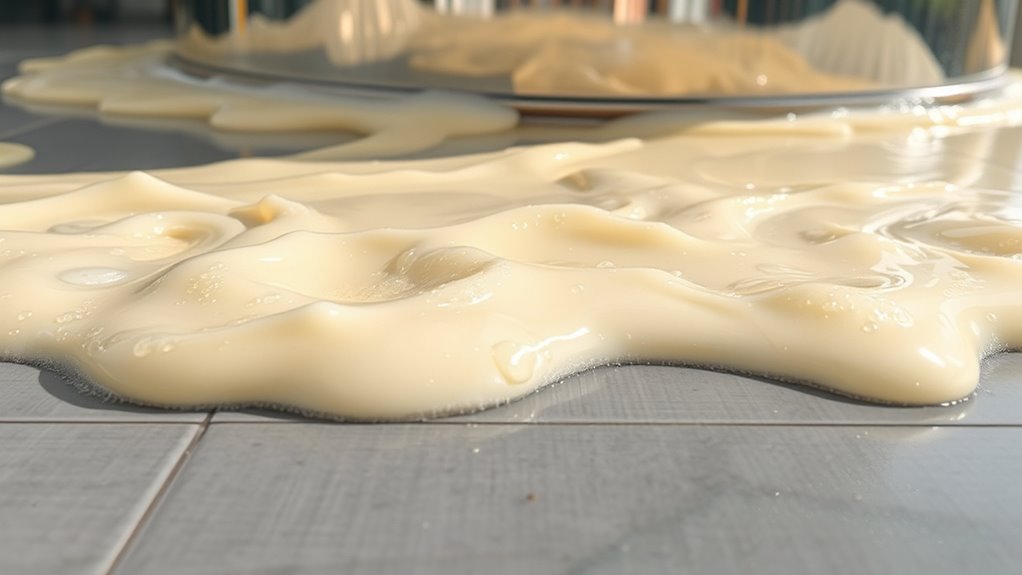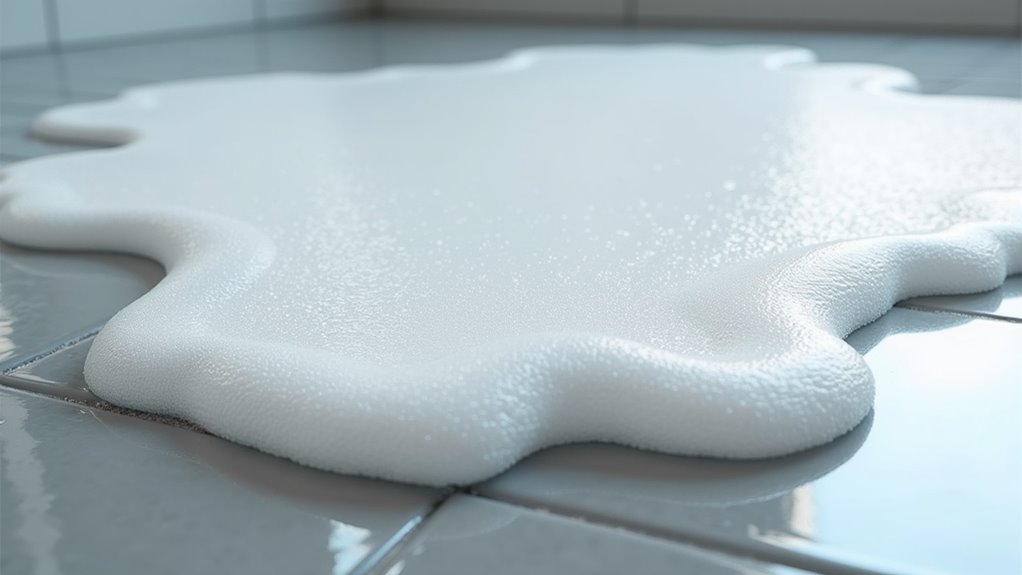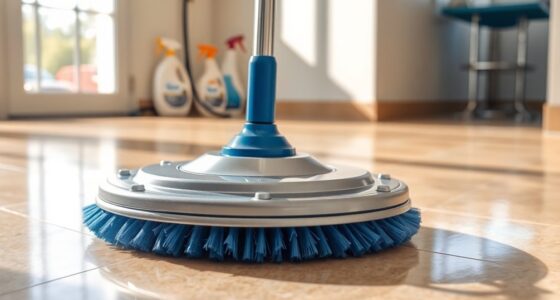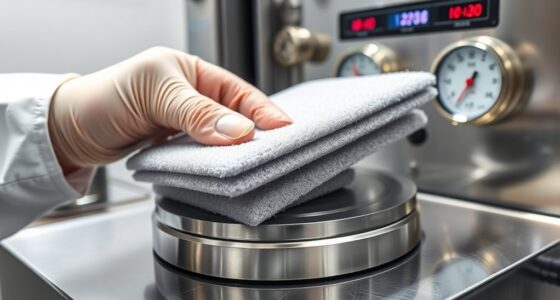Foam in your recovery tank on tile floors often comes from chemical interactions between cleaning agents and residues, which produce stable foam that’s hard to break down. To control this, you should use a suitable defoamer designed for your system and apply it according to instructions. Regular maintenance, like rinsing the tank and avoiding incompatible chemicals, also helps prevent foam buildup. Keep exploring to learn more effective strategies for managing foam and maintaining smooth operations.
Key Takeaways
- Use a compatible defoamer specifically formulated for recovery tanks to effectively break down foam.
- Apply the defoamer gradually, following manufacturer instructions, to prevent over-application and chemical waste.
- Regularly rinse and clean the tank to remove residues that promote foam stability and build-up.
- Adjust the chemical concentrations to minimize reactions that produce persistent foam during cleaning.
- Maintain consistent monitoring and maintenance routines to prevent foam formation and ensure efficient tank operation.

Have you ever noticed foam forming in your recovery tank? If you have, you’re likely wondering what causes it and how to get it under control. Foam can be a common issue in cleaning systems, especially when working with tile floors, and understanding the underlying reasons can help you manage it more effectively. One of the main factors contributing to foam formation is chemical interactions. When cleaning agents, detergents, or surfactants are introduced into the recovery tank, they can react with residues, dirt, or other chemicals present in the water. These interactions often produce stable foam that’s difficult to eliminate without intervention. Recognizing which chemicals are compatible and how they interact can prevent excessive foam buildup and improve your cleaning efficiency.
Chemical interactions in the recovery tank often cause stubborn foam buildup during cleaning.
Maintaining proper procedures in your cleaning routine is essential to minimize foam and keep your recovery tank functioning at its best. Regular maintenance procedures include thoroughly rinsing the tank to remove residual chemicals, avoiding the mixing of incompatible solutions, and monitoring the concentration of cleaning agents used. When you follow these steps consistently, you reduce the likelihood of unwanted chemical interactions that lead to foam. Additionally, inspecting and cleaning filters and other equipment components can prevent buildup that might trap foam-forming residues. Proper maintenance not only extends the life of your equipment but also ensures that your cleaning process remains smooth and foam-free.
Another key aspect is selecting the right defoamer products, which are designed specifically for these situations. Using a defoamer can quickly break down foam caused by chemical interactions, restoring the tank’s normal operation. When applying a defoamer, make sure you follow the manufacturer’s instructions carefully, as overuse can cause other issues or interfere with cleaning performance. Preventative measures, like adjusting the chemical concentrations or switching to low-foam formulations, can also help mitigate foam formation before it becomes a problem.
In essence, understanding the chemistry behind foam formation and adhering to proper maintenance procedures allows you to control and prevent foam in your recovery tank. By paying attention to chemical interactions and establishing consistent maintenance routines, you’ll keep your cleaning equipment running efficiently. This proactive approach minimizes downtime, reduces chemical waste, and ensures your tile floors are cleaned effectively without the nuisance of persistent foam. Ultimately, a well-maintained system and the right chemical choices make all the difference in managing foam in your recovery tank, keeping your operations smooth and hassle-free.
Frequently Asked Questions
Can Foam Damage My Tile Flooring?
Foam buildup itself typically won’t damage your tile flooring, but prolonged exposure to foam and moisture can cause staining or weakening if not addressed. You should regularly inspect your tank for foam buildup and guarantee proper drainage. Using a defoamer helps control foam, preventing it from spilling over and coming into contact with your tiles. Prompt tank inspection and maintenance keep your floors safe and prevent potential damage.
How Often Should I Check the Recovery Tank for Foam?
You should check your recovery tank for foam buildup daily during tank maintenance. Regular inspections help you catch excessive foam early, preventing potential damage to your tile floors and ensuring ideal machine performance. If you notice foam accumulating quickly, consider adding a defoamer or adjusting your cleaning process. Staying proactive about tank maintenance minimizes risks and keeps your equipment running smoothly without risking damage to your flooring.
Are There Eco-Friendly Defoamers Available?
Like the gentle flow of a clear stream, eco-friendly defoamers exist with biodegradable options and natural ingredients that are safe for the environment. You can find these alternatives at most suppliers, ensuring you reduce chemical impact while maintaining effective foam control. Switching to natural ingredients not only benefits the planet but also keeps your workspace healthier. So, yes, eco-friendly defoamers are readily available, combining effectiveness with sustainability.
Will Using a Defoamer Affect Cleaning Performance?
Using a defoamer won’t substantially affect your cleaning efficiency if you choose the right one. Properly formulated defoamers are designed to minimize chemical interactions that could hinder cleaning performance. They work by breaking down foam without interfering with cleaning agents, ensuring your process remains effective. Just be sure to select a compatible product, and you’ll maintain ideal cleaning results while controlling foam in your recovery tank.
Can Foam Indicate a Larger Machine Malfunction?
Yes, foam indicators can signal a larger machine malfunction. Excessive foam often points to issues like clogged filters, faulty valves, or improper chemical use. If you notice persistent foam, it’s a sign you should inspect your equipment thoroughly. Addressing these foam indicators promptly helps prevent further damage, ensuring your machine operates efficiently and reducing the risk of costly repairs down the line.
Conclusion
When foam starts bubbling over in your recovery tank, remember, a good defoamer is your best friend—think of it as the calm in your cleaning storm. Don’t let foam turn your tile floors into a sudsy mess; instead, tackle it head-on with a quick application. After all, isn’t a smooth surface and a clear mind worth a little extra effort? Keep your tank running smoothly, and your cleaning day will be a breeze!









